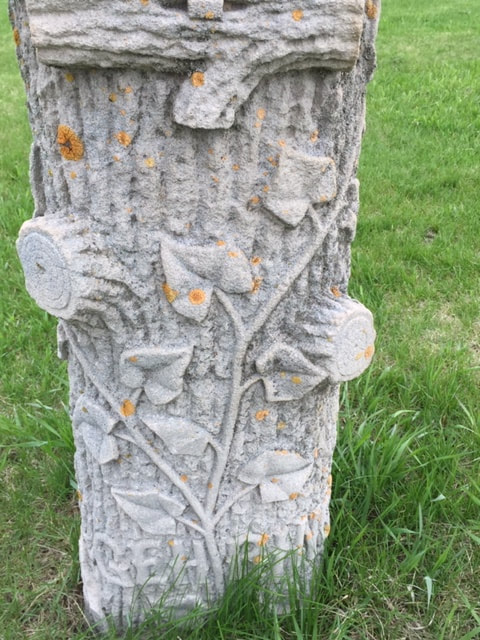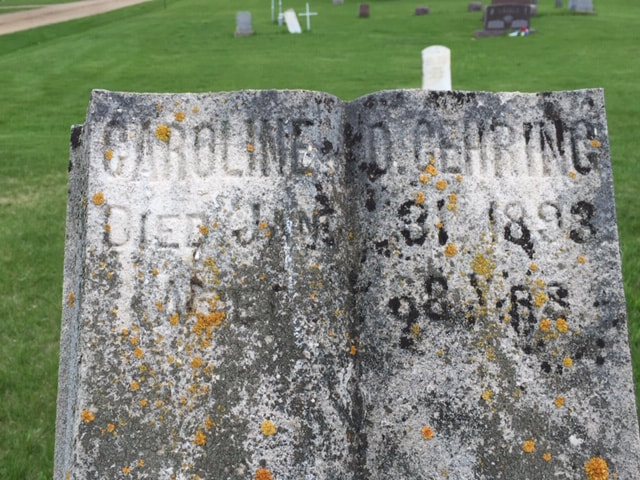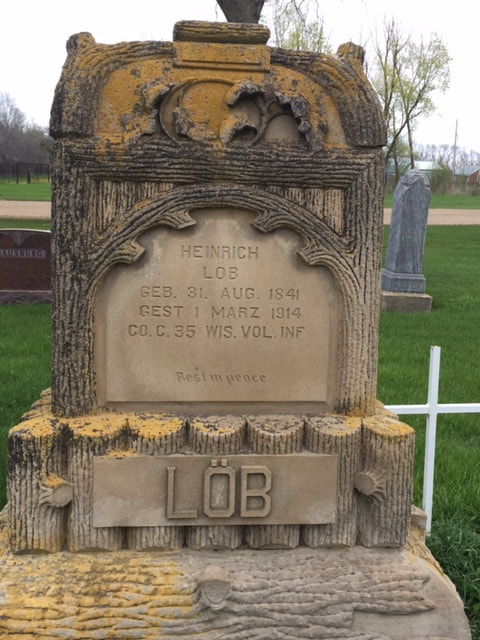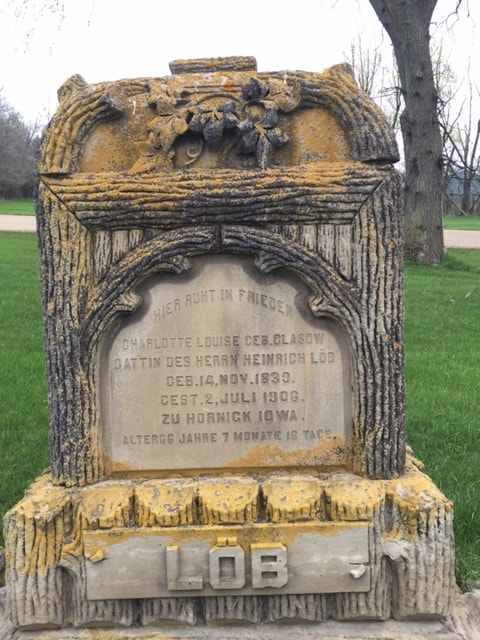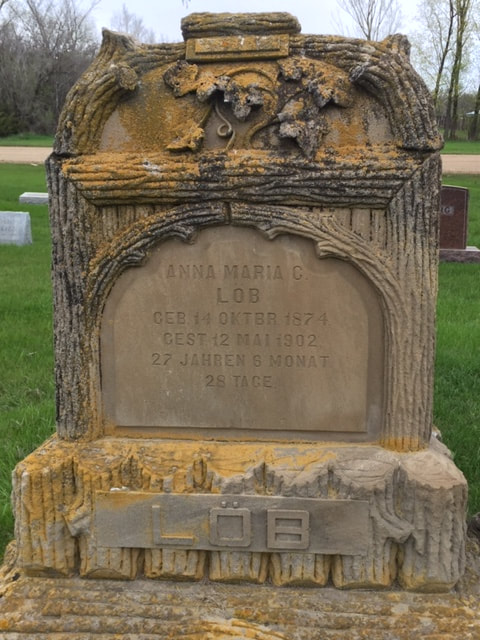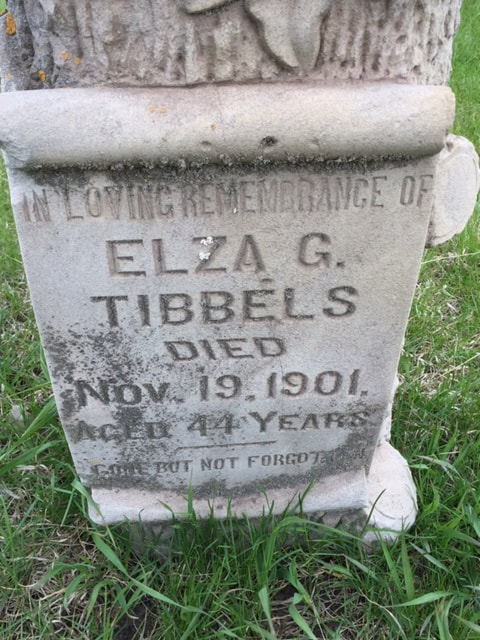Grave markers shaped like tree stumps can be found in old cemeteries across the U.S. and in foreign countries as well. Most date from the 1880s to 1920s, when funerary art in the United States moved away from grand mausoleums and obelisks to more simple grave markers. Tree-stump grave markers were also part of a movement to turn the focus away from death back to the life of the deceased. For the Victorians, grave markers shaped like tree stumps or with tree stump imagery as part of the gravestone was a powerful symbol of both eternity and humanity, recalling the Bible's tree of life and tree of knowledge.
Today, those old tree-stump tombstones qualify as a form of folk art – and they also provide a link to the secret societies of the time. The tree-stump gravestones were carved to look like tree stumps and often had intricate details at the base and along the trunk. Elements from nature were sometimes added to better tell the life story of the deceased. The tree-stump stones themselves took many shapes: a single vertical stump, a double vertical stump, a horizontal stump, a ledger tree stump, a tree-stump bench, a tree-stump chair, a tree-stump cross. The stones also varied according to the area they were carved in, the type of cemetery and the stone mason who did the work. For example, a stone carver in Illinois reportedly added mushrooms to all his tree-stump tombstones, as a way to mark his work.
In many cases, the tree stump was carved with the top cut off at an angle to symbolize a life cut short. The tree stones varied in both girth and height. The grave markers were often 5-6 feet tall, especially when the marker guarded the grave of a grown man or woman. Others were much shorter, just a foot or so, to signify the short life of a child who died before growing up. Or a small stack of 3 small tree stumps might be used to mark a child’s grave.
One fraternal organization, Woodmen of the World, is strongly linked to tree-stump tombstones. Joseph Cullen Root, from Omaha, Nebraska, founded Modern Woodmen of America (1883) and also Woodmen of the World (1890), both fraternal insurance benefit societies. The Woodmen organizations recruited rural farmers as members and were formed to provide members’ families with a source of income after the death of the family’s breadwinner – essentially the first life insurance policies. Membership reached 88,000 by 1898 and 750,000 in 1915. Among its rituals, its members conducted drills with axes, but their “woodcraft” was mostly symbolic -- inspired by the image of pioneers clearing out forests to provide for their families.
From 1890 to 1900, Woodmen of the World’s life insurance policies included a proviso that provided for tree-stump grave markers, free of charge, for members. From 1900 to the mid-1920’s, members purchased a $100 rider to cover the cost of the monument. By the mid-1920’s, the increased cost of the stones caused the organization to discontinue the grave marker benefit. Woodman of America continued to offer tree-stump grave markers to its members until the mid-1970’s, but the grave markers were, of course, no longer an insurance benefit and no longer free.
As tree-stump gravestones became more popular, the Sears and Montgomery Wards catalogues offered them for sale to the general public. However, tree-stump tombstones marked with WOW or the organization’s motto in Latin or with an axe or a maul or other woodworking tool indicated that the deceased was a member of one of the Woodman organizations.
-Written by Cecelia Wittmayer, originally printed in the Miner County Pioneer
Today, those old tree-stump tombstones qualify as a form of folk art – and they also provide a link to the secret societies of the time. The tree-stump gravestones were carved to look like tree stumps and often had intricate details at the base and along the trunk. Elements from nature were sometimes added to better tell the life story of the deceased. The tree-stump stones themselves took many shapes: a single vertical stump, a double vertical stump, a horizontal stump, a ledger tree stump, a tree-stump bench, a tree-stump chair, a tree-stump cross. The stones also varied according to the area they were carved in, the type of cemetery and the stone mason who did the work. For example, a stone carver in Illinois reportedly added mushrooms to all his tree-stump tombstones, as a way to mark his work.
In many cases, the tree stump was carved with the top cut off at an angle to symbolize a life cut short. The tree stones varied in both girth and height. The grave markers were often 5-6 feet tall, especially when the marker guarded the grave of a grown man or woman. Others were much shorter, just a foot or so, to signify the short life of a child who died before growing up. Or a small stack of 3 small tree stumps might be used to mark a child’s grave.
One fraternal organization, Woodmen of the World, is strongly linked to tree-stump tombstones. Joseph Cullen Root, from Omaha, Nebraska, founded Modern Woodmen of America (1883) and also Woodmen of the World (1890), both fraternal insurance benefit societies. The Woodmen organizations recruited rural farmers as members and were formed to provide members’ families with a source of income after the death of the family’s breadwinner – essentially the first life insurance policies. Membership reached 88,000 by 1898 and 750,000 in 1915. Among its rituals, its members conducted drills with axes, but their “woodcraft” was mostly symbolic -- inspired by the image of pioneers clearing out forests to provide for their families.
From 1890 to 1900, Woodmen of the World’s life insurance policies included a proviso that provided for tree-stump grave markers, free of charge, for members. From 1900 to the mid-1920’s, members purchased a $100 rider to cover the cost of the monument. By the mid-1920’s, the increased cost of the stones caused the organization to discontinue the grave marker benefit. Woodman of America continued to offer tree-stump grave markers to its members until the mid-1970’s, but the grave markers were, of course, no longer an insurance benefit and no longer free.
As tree-stump gravestones became more popular, the Sears and Montgomery Wards catalogues offered them for sale to the general public. However, tree-stump tombstones marked with WOW or the organization’s motto in Latin or with an axe or a maul or other woodworking tool indicated that the deceased was a member of one of the Woodman organizations.
-Written by Cecelia Wittmayer, originally printed in the Miner County Pioneer
Gehring
Found in Graceland Cemetery south of Howard.
Lob
Found in St. John’s Lutheran Cemetery east of Howard.
Tibbels
Found in Graceland Cemetery south of Howard.
